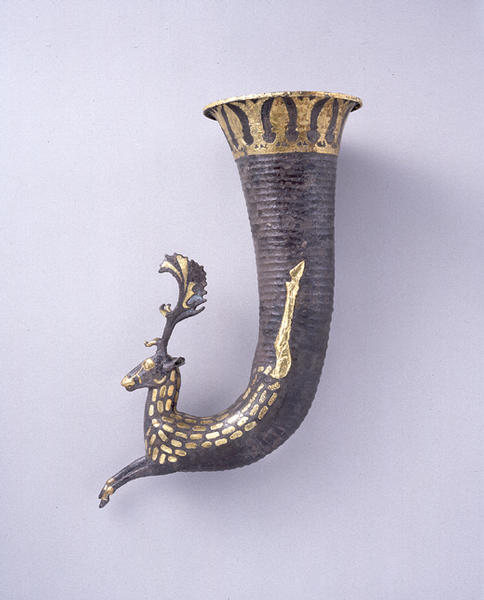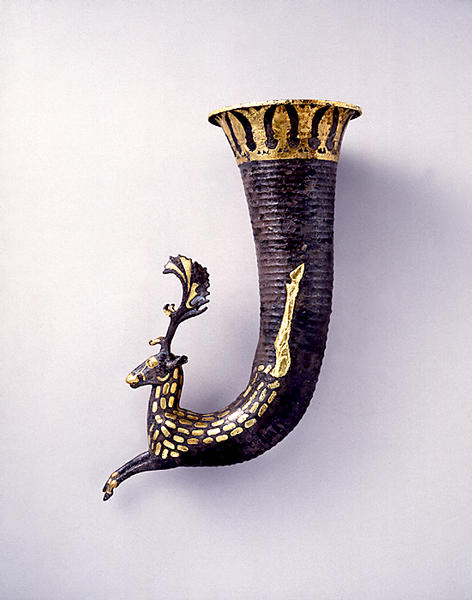牡鹿形リュトン
- アケメネス朝ペルシア
- 紀元前5-紀元前4世紀
- 鍍金銀
- H-31 D-11
この作品は銀で形成し金箔の象嵌を各所に施している。この器縁に施されたロータスと蕾あるいは樹木の連続意匠や、ペルセポリスの牡牛の柱頭にも見られる瞼を強調した表現、目頭から鼻面に向かう途中で分岐する血管の意匠はアッシリア由来のものと思われる。しかしその前方に揃えて差し出された前脚はライオンやグリフィンの要素であり、牛や羊など偶蹄類は通常前脚を折って表現されてきた。ダレイオスがスサの定礎石版に刻ませた銘文には、都の建設にあたって金細工師や象嵌細工師などを遠隔の地から集めたことが言及されているが、このような関連からも必然的にアケメネス朝の様式は多くの文化の要素を結合したものになって行ったのである。
金製・銀製容器(古代バクトリア遺宝展)
バクトリア遺宝で容器は大きな部分を占め、22点の金器(作品123~144)、26点の銀器(作品97~122)が含まれる。銀器の中には背の高いアケメネス朝の灌頂用ゴブレット型をしたものが6個(作品103~106、108、109)あるが、その装飾はヘレニズム期の特徴をもっている。これに似たカップを、線刻や押し出し技法で奉納金板に表された神官が持っている。同様に灌頂用のリュトンが5個(作品116~119、122)あるが、その内3個(作品118、119、122)は器前方の断片である。更に8個の銀製灌頂用浅鉢(作品97~99、101、102、111~113)があるが、金製の器と同様の目的に使われた。18個の金製灌頂用鉢(作品123~140)は等しく丸い底と広がった縁をもっている。ピクシス型をした容器(作品142)は蓋がついており、これらの器の中では一番古い部類に属している。特に興味深いものは香炉(作品141)で内側に四つの環が付き、これに紐をとおして提げたものであろう。
これらの器は概して大英博物館のオクサス遺宝よりも大振りであるが、同じ用途に使われたものと思われ、ペルセポリスの浮彫に刻まれた人物が持つ器に近い形状をしている。この関連からこれらの器の年代を考えることができる。これとともに、ペルセポリス型のゴブレットやリュトンを作る光景が、エジプトのヘルモポリス・マグナにあるペトシリスの墓のプロナオスに浮彫で表されていることは特筆に価する。マスカレラによれば、この浮彫は前300年頃の鍛金工房の様子を描いたものに相当する。
香炉
ロゼット文浅鉢
ロゼット文浅鉢
ロゼット文フィアラ杯
ロゼット文鉢
フィアラ杯
ロゼット文浅鉢断片
ロゼット文鉢
ロゼット文鉢
ロゼット文鉢
ロゼット文鉢
ロータス・パルメット文鉢
ロゼット文鉢
人頭装飾鉢
ロゼット文鉢
植物文杯
ケートス文皿
鉢
人物装飾鉢
獅子頭形杯
馬形リュトン
馬形リュトン断片
ラマッス形リュトン断片
双獅子形柄杓装飾
円盤(鏡)
ライオングリフィン形リュトン断片
浅鉢
浅鉢
浅鉢
鉢
鉢
鉢
鉢
鉢
鉢
鉢
鉢
鉢
鉢
鉢
鉢
鉢
鉢
鉢
蓋付鉢
解説(古代バクトリア遺宝展)
アケメネス朝時代(前6―前4世紀)
鍍金銀
高31.0 cm 口径11.0 cm
このリュトンの先端部は、前脚を伸ばした牡鹿の姿になっている。手のひらを広げたような特徴的な角と体の斑点から、ダマジカを表していることがわかる。別造された杯部には、反り身になり後脚をぴんと伸ばした鹿の後半身が打ち出されており、杯の湾曲を利用して躍動感あふれる姿態を表現している。前半身部分とは、鹿の胴体の中ほどで極めて巧妙に接合されており、継ぎ目は肉眼では判別できない。両前脚の間に注口がある。杯部には横畝装飾を施し、ギローシュ文で画した口縁部にはロータス文とパルメット文を交互に繋いで巡らす。主要な部分には金箔を貼り付けて、装飾効果を高めている。
本作品は形状、鹿の顔の表現、杯部装飾にアケメネス朝美術の特徴を示している。類品としてはメトロポリタン美術館シンメル・コレクションの、杯部に後半身が打ち出され、口縁部に植物文のある銀製牡羊形リュトンを挙げることができよう。しかし動物の造形において後者がやや様式化された重厚な表現法を示すのに対して、本作品では、アンフォラの山羊形把手にも共通するアケメネス朝美術の優美で華麗な側面が強調されている。
Catalogue Entry(Bac#117)
Achaemenid period (6th‐4th century B.C.)
Gilded silver
H. 31.0 cm, Mouth dia. 11.0 cm
The tip of this rhyton is shaped like a stag with extended forelegs. The stag's horns are shaped like spread hands, and the body is decorated with spots, indicating that it is a Dama dama deer. The separately formed cup is decorated with hammered designs depicting the stag's extended hind legs and hindquarters, and the artist used the curving shape of the cup to give a feeling of leaping motion to the animal's form. The forequarters and hindquarters are skillfully joined at the middle of the animal's torso, so that the joint cannot be discerned with the naked eye. The spout is place between the animal's forelegs. The cup section is decorated with horizontal grooves, while the mouth rim area is decorated with guilloches, with a pattern of alternating lotus motifs and palmetto motifs. The major motif areas are plated with gold foil, and this shine heightens the decorative affect of the piece.
The expression of the stag's face, the shape of the vessel, and the decoration on the cup are all characteristic of the Achaemenid period. A similar work in the Metropolitan Schimmel Collection is a silver rhyton with ram decoration with the same hammered out hindquarters and plant motifs on the mouth rim area. However the formation of the animal on the Metropolitan work is somewhat more stylized and heavily formed. By comparison, this work emphasizes the elegant and lively beauty of the Achaemenid period arts seen in their amphoras with ram-shaped handles.
Vessels
The "vessels" division is represented by a relatively large number of objects.There are 22 items of gold (cat. Nos. 123-144) and 26 of silver (cat. Nos. 97-122). Among the silver vessels, there are 6 goblets (cat. Nos. 103-106, 108, 109) tall libation vessels Achaemenid in form, but decorated in a style which is typically Hellenistic. Similar cups are held by the magi represented on the relief sculptures and votive plaques. Three rhyta made for a similar purpose are unfortunately in a fragmentary condition (cat. Nos. 118, 119, 122). In addition there are 8 shallow bowls (cat. Nos. 97-99, 101, 102, 111-113) for ritual libations. The gold vessels were used for the same purpose; there are 18 libation bowls, of simple form, most of which have a rounded base and everted rim (cat. Nos. 123-140). One tall vessel of a pyxis type with a lid (cat. No. 142) appears to be the earliest of the vessels in the collection. Of special interest is an incense burner in the form of a censer with four rings for suspension (cat. No. 141).
Although the number of vessels in this collection is considerably larger than those of the Oxus Treasure in the British Museum, they probably served the same function. The vessels of both collections are closely paralleled by the vessels held by worshippers depicted on the Persepolis reliefs. This observation makes it possible to date them. It is worth adding here that the manufacture of goblets of similar shape and of rhyta in the Persepolitan style is depicted on a relief in a pronaos on the northern wall of the tomb of Petosiris at Hermopolis Magna in Egypt. According to Muscarella, the reliefs attest the manufacture of embossed articles in Egypt right up until 300 BC.
香炉
ロゼット文浅鉢
ロゼット文浅鉢
ロゼット文フィアラ杯
ロゼット文鉢
フィアラ杯
ロゼット文浅鉢断片
ロゼット文鉢
ロゼット文鉢
ロゼット文鉢
ロゼット文鉢
ロータス・パルメット文鉢
ロゼット文鉢
人頭装飾鉢
ロゼット文鉢
植物文杯
ケートス文皿
鉢
人物装飾鉢
獅子頭形杯
馬形リュトン
馬形リュトン断片
ラマッス形リュトン断片
双獅子形柄杓装飾
円盤(鏡)
ライオングリフィン形リュトン断片
浅鉢
浅鉢
浅鉢
鉢
鉢
鉢
鉢
鉢
鉢
鉢
鉢
鉢
鉢
鉢
鉢
鉢
鉢
鉢
蓋付鉢

